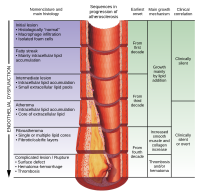
Photo from wikipedia
Background: Congenitally corrected transposition of the great arteries is a rare form of congenital heart disease. Management is controversial; options include observation, physiologic repair, and anatomic repair. Assessment of morphologic… Click to show full abstract
Background: Congenitally corrected transposition of the great arteries is a rare form of congenital heart disease. Management is controversial; options include observation, physiologic repair, and anatomic repair. Assessment of morphologic left ventricle preparedness is key in timing anatomic repair. This study's purpose was to review the modalities used to assess the morphologic left ventricle preoperatively and to determine if any echocardiographic variables are associated with outcomes. Methods: A retrospective review of patients with congenitally corrected transposition of the great arteries eligible for anatomic repair at Lucile Packard Children's Hospital from 2000 to 2016 was conducted. Inclusion criteria were (1) presurgical echocardiography, magnetic resonance imaging, and cardiac catheterization and (2) clinical follow‐up information. Echocardiographic measurements included left ventricular (LV) single‐plane Simpson's ejection fraction, LV eccentricity index, LV posterior wall thickening, pulmonary artery band (PAB)/LV outflow tract (LVOT) pressure gradient, and LV and right ventricular strain. Magnetic resonance imaging measurements included LV mass, ejection fraction, eccentricity index, and LV thickening. LV pressure, PAB/LVOT gradient, right ventricular pressure, pulmonary vascular resistance, and Qp/Qs constituted catheterization data. Outcomes included achieving anatomic repair within 1 year of assessment in patients with LVOT obstruction or within 1 year of pulmonary artery banding and freedom from death, transplantation, or heart failure at last follow‐up. Results: Forty‐one patients met the inclusion criteria. PAB/LVOT gradients of 85.2 ± 23.4 versus 64.0 ± 32.1 mm Hg (P = .0282) by echocardiography and 60.1 ± 19.4 versus 35.9 ± 18.9 mm Hg (P = .0030) by catheterization were associated with achieving anatomic repair and freedom from death, transplantation, and heart failure. Echocardiographic LV posterior wall thickening of 35.4 ± 19.8% versus 20.6 ± 15.0% (P = .0017) and MRI LV septal wall thickening of 37.1 ± 18.8% versus 19.3 ± 18.8% (P = .0306) were associated with achieving anatomic repair. Inter‐ and intraobserver variability for echocardiographic measurements was very good. Conclusions: PAB/LVOT gradient and LV posterior wall thickening are highly reproducible echocardiographic measurements that reflect morphologic LV performance and can be used in assessing patients with congenitally corrected transposition of the great arteries undergoing anatomic repair. HighlightsThe authors assessed imaging techniques in patients with CCTGA.Echocardiography was an important tool for assessing the morphologic left ventricle before anatomic repair.Intrinsic or PAB‐associated LVOT gradient was a useful measurement of LV preparedness for anatomic repair.LVPW thickening was also useful in assessing the left ventricle before anatomic repair.
Journal Title: Journal of the American Society of Echocardiography
Year Published: 2017
Link to full text (if available)
Share on Social Media: Sign Up to like & get
recommendations!